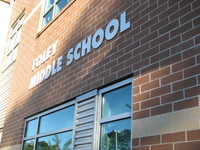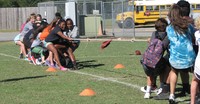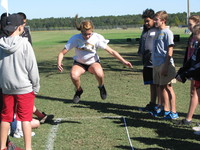With three schools feeding into Foley Middle School, you would expect FMS to be at capacity, especially with nearby Foley Elementary School as one of the largest elementary schools in the state; …
This item is available in full to subscribers.
Please log in to continue |



With three schools feeding into Foley Middle School, you would expect FMS to be at capacity, especially with nearby Foley Elementary School as one of the largest elementary schools in the state; however, it is quite the opposite, which is not the norm for many schools in our ever-growing county.
Foley Intermediate School, Magnolia School and Swift Consolidated School all feed into FMS for seventh and eighth grade before students move to Foley High School. According to Attendance Clerk Christina Bailey, the total number of students stays between 700 and 730.
“Right now, we’re at approximately 715 students,” she said. “We don’t have a huge influx. I’ve only been here for one and a half years, and for the entire school year I’ve been here, I’ve only seen a change of about 30 kids.”
Assistant Principal P.J. Sute said the middle school has room to grow.
“We’re good on space,” she said. “We have about 700 seventh and eighth graders … we are large, but we’re not busting at the seams as far as space and teachers. We’ve been fortunate with Title I funding the past few years to get more teachers.”
There are no portables at Foley Middle and the building is less than 10 years old, new compared to other school buildings in the county. The average number of students in a classroom is 24, according to Bailey; some classrooms have up to 31. As far as the number of new students each year, the number stays about the same at the beginning of the year and a few students transfer in and out of the school.
“When the intermediate schools and other schools come over, we average about 250 new students a year,” Bailey said. “Kids come and go throughout the year, and that number averages about 30 students.”
Of the approximate 700 students, 65 to 70 percent of those students receive free or reduced-cost lunch. The number of students that qualify for free or reduced-cost lunch affects the status as far as Title I funding schools receive; this is Foley Middle’s second year to receive the federal funds.
“We use our budget and disperse the funds as we see needed,” Sute said. “We have hired teachers, used it for instruction, tutoring programs, hire certified teachers and 19-hour tutors that come and work with the students. We focus more on instruction instead of just the materials.”
Part of Title I funding at FMS is to fund after-school tutoring.
“It helps some of our students who maybe are trailing behind to help catch them up,” Bailey explained.
This year, the school is able to provide transportation services to students after tutoring that may not have it available.
“It is new this year and I think it’s working out really well,” Bailey said.
As far as the seventh and eighth grader’s daily schedule, not too much has changed with the exception of homeroom.
“We no longer have homeroom in the mornings,” Bailey said. “Seventh grade homeroom is while eighth grade is at lunch, and eighth grade home room is while seventh grade is at lunch.”
Even with homeroom in the middle of the day, Bailey thinks it’s working out well for the first year.
“I do attendance, so I personally feel the kids hurry up and get to class versus checking in late,” she said. “Their day gets started faster.”
Everything else is fairly normal; students have seven periods: six classes plus Pride Block, which is what the school calls homeroom. Seventh and eighth graders are all required to take PE, and all students are required to take an enrichment course both years. Part of PE is put aside for students to have their “break” or “snack.”
When students are released in the afternoons, there are two waves: the first wave of buses with walkers and car riders, and the second wave of buses.
As far as discipline, Bailey feels like there isn’t much of a problem with the students at the school.
“I feel like we have really good students here,” she said. “With that being said, we have really good administrators who are always good about keeping eyes in the hallways. We always have teachers in the hallway when classes are changing and counselors who are staying involved. They maybe hear of some tension or a potential issue and they’re quick to step in and say, ‘Hey, what’s going on? Let’s get this out there; let’s not let this escalate.’ I feel like they do a great job. All of those components really help keep our discipline to a minimum.”
The teachers at Foley Middle School go above and beyond for their students in regards to their testing scores and ensuring student know how they are doing in their classes.
“We give each student a large, three-ring binder and give them all their testing scores throughout the year so they can reference them at any time,” Bailey said.
Bailey said the original test score does go home, but after a parent or guardian sees it, it may go in a file folder or the trash.
“This is an extra step for us — making 750 copies of every test and getting it to each student — but it’s a good thing for the students to see those scores,” she said. “We also provide data for our teachers. We have a big spreadsheet so they can look at it and target certain students that may be in certain ranges who need assistance.”
Principal Danny McDuffie gave teachers and staff test results and changes from 2013 to 2016 to show the changes in math, reading and science scores. Overall math proficiency increased 46 percent from 2013 to 2016; overall reading increased 34 percent; and science improved 13 percent in three years. The same students in eighth grade improved from their seventh grade reading scores from 22 percent to 35 percent during the 2014-2015 school year. Eighth grade science improved the same students in eighth grade from their seventh grade scores, 26 percent to 30 percent.
Although most learning takes place in a desk in a classroom, the teachers at Foley Middle School make sure the students have some fun while still learning.
Last week, eighth grade students had their annual Olympic Day, a tradition at Foley Middle School for over 10 years.
“Students study ancient Greece and their contributions across all the curriculums and end the week with Olympic Day,” said Marilyn Ward, social studies teacher at FMS. “We discuss the ancient Olympics and compare them to the Olympics today”
During Olympic Day, some of the events are shot-put, discus and running, that were found in the ancient games. Other non-athletic events are added for students to participate in as well, like the Temple Build.
“The students build catapults in science and compete to see what catapult can shoot a candy pumpkin,” Ward explains. “Mathematics does an activity in which they measure to see if they have a Golden Greek Face.”
Awards are given to all winners in the events — gold, silver and bronze—and this year, the students’ team won by the number of medals they were awarded.
Students really enjoyed each event, from the chariot race to the torch run, and without knowing it, they’re learning and recapping what they learned the previous lesson.